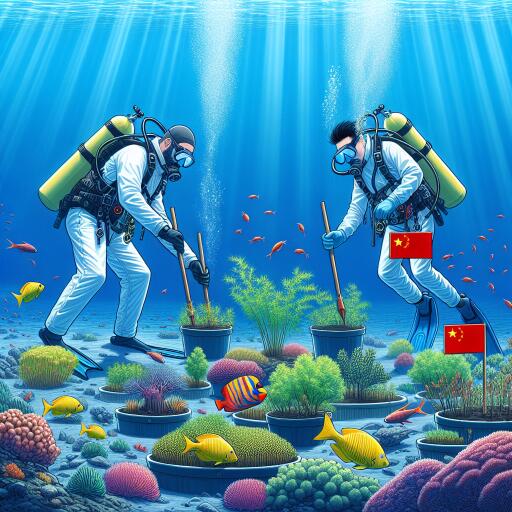
Feature: China and Mauritius Collaborate on Pioneering Underwater Reforestation Initiative
In the vast expanse of the Indian Ocean off Mauritius’s east coast, an innovative project is breathing new life into the underwater world. Near Pointe aux Feuilles, coral nurseries cradle the future of the ocean’s biodiversity, harboring fragments of coral that, upon reaching maturity, will be transplanted to rejuvenate degraded reef ecosystems.
Through a visionary partnership between Chinese technology conglomerate Huawei and Mauritius’s EcoMode Society, a non-governmental environmental advocacy group, the initiative has achieved remarkable success. Minister Sudheer Maudhoo of Blue Economy, Marine Resources, Fisheries, and Shipping proudly announced the cultivation and transplantation of “25,000 coral fragments across an area of 1.01 square kilometers.”
Mauritius, an island nation, is encircled by over 150 kilometers of coral reefs that are not only ecological treasures but also crucial for economic and social wellbeing. These reefs, often referred to as the rainforests of the sea, are teeming with life, providing habitat for countless marine species and acting as a natural defense against the ravages of storms. However, threats such as climate change, overfishing, and pollution have placed these vital ecosystems in jeopardy.
Nadeem Nazurally, an assistant professor at the University of Mauritius’s Agriculture Faculty and a long-standing advocate for marine protection, recounted the traditional challenges of coral cultivation as “lengthy and cumbersome,” lamenting the lack of real-time insights into underwater developments. The presence of predators like the crown-of-thorns starfish, capable of devastating young coral colonies overnight, underscored the need for a more responsive conservation strategy.
The establishment of a technologically advanced coral reef restoration campaign has revolutionized these efforts. Employing Chinese technological innovations, including underwater cameras, GPS, 5G networks, and cloud data storage, the team can now monitor the nurseries remotely. “With Chinese technology, we can intervene in real-time, preventing the kind of setbacks that previously undermined our work,” explained Nazurally, president of EcoMode Society.
Li Jiyu, a technical engineer from Huawei Mauritius, highlighted the deployment of these technologies not only for monitoring but also for researching and understanding the complex dynamics at play within reef ecosystems. This collaboration has marked the beginning of the project’s second phase, which promises to leverage AI for data analysis, further supporting conservation efforts, marine biologists’ research, and public education on reef preservation.
Nazurally also mentioned the direct benefits to academic research, stating that the data collected through these technological solutions offer invaluable insights into phenomena such as coral bleaching and interactions within the marine ecosystem. This information is shared with the University of Mauritius, contributing to broader understanding and conservation strategies.
This joint endeavor between China and Mauritius exemplifies the potential of merging cutting-edge technology with environmental conservation. As this project continues to evolve, it stands as a beacon of hope for coral reefs worldwide, demonstrating the power of international collaboration in safeguarding our planet’s underwater biodiversity.





Leave a Reply